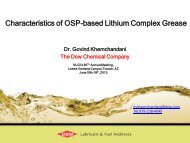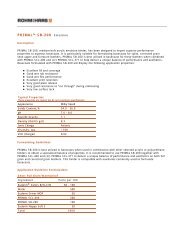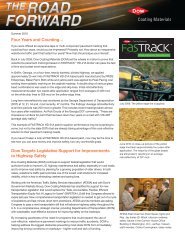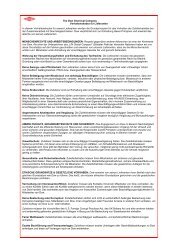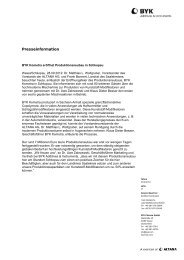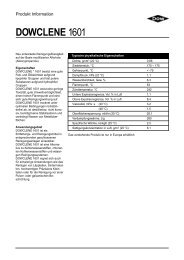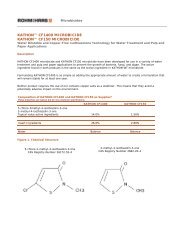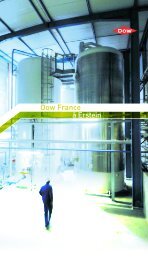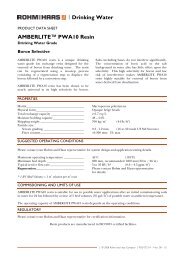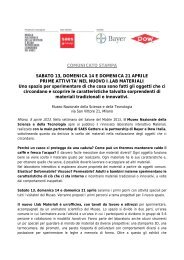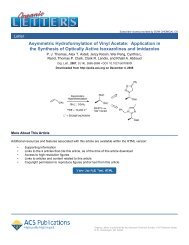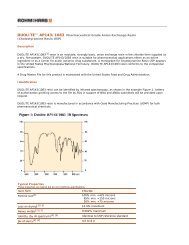Granulation with Dow Cellulosic Polymers II. High Shear Granulation
Granulation with Dow Cellulosic Polymers II. High Shear Granulation
Granulation with Dow Cellulosic Polymers II. High Shear Granulation
You also want an ePaper? Increase the reach of your titles
YUMPU automatically turns print PDFs into web optimized ePapers that Google loves.
The data for METHOCEL K3P LV<br />
and the two viscosity grades of PVP<br />
at 3%w/w binder are presented in<br />
Figure 33, which illustrates the<br />
unimportance of the method in which<br />
the binder was added. The dissolution<br />
of tablets containing PVP (K90) was<br />
about 6 minutes slower than those<br />
prepared <strong>with</strong> the METHOCEL<br />
cellulose ether, which was in turn<br />
about 3-4 minutes slower than that of<br />
tablets prepared <strong>with</strong> PVP (K29-32).<br />
The same general trends were<br />
evident at the 6% binder level, where<br />
the t 80% values were approximately<br />
15 minutes, 19 minutes, and 29<br />
minutes for PVP (K29-32),<br />
METHOCEL K3P LV, and PVP<br />
(K90), respectively.<br />
The final figure, Figure 34, compares<br />
the performance of METHOCEL<br />
K3P LV and acacia at 6% <strong>with</strong> that of<br />
the pregelatinized starch at the 10%<br />
level. (Recall that the acacia and<br />
pregelatinized starch were only<br />
utilized in the solution binder addition<br />
method.) The acacia tablets dissolved<br />
relatively rapidly, while the profile of<br />
tablets prepared <strong>with</strong> the modified<br />
starch was virtually indistinguishable<br />
from that of tablets made <strong>with</strong><br />
METHOCEL K3P LV.<br />
20 <strong>High</strong> <strong>Shear</strong> <strong>Granulation</strong>: Vitamin C Model<br />
Conclusions: Vitamin C Model<br />
Formulation<br />
The METHOCEL and HPC polymers<br />
formed good granules <strong>with</strong> good<br />
milling properties, both when added<br />
as aqueous solutions to the high<br />
shear mixer-granulator, or added as<br />
a dry powder to the unit followed by<br />
granulation <strong>with</strong> water. Good<br />
densities, comparable <strong>with</strong> the<br />
competitive binders, were obtained<br />
<strong>with</strong> both binder addition methods.<br />
The particle size distributions<br />
appeared to be completely<br />
satisfactory. The majority of the<br />
granules were retained on the 20,<br />
40, and 60 mesh screens; less than<br />
20% of the material was finer than<br />
140 mesh (<strong>with</strong> the exception of<br />
PVP (K90).<br />
Increasing the amount of binder in<br />
the granulations caused an increase<br />
in hardness in 72% of the cases<br />
studied, caused a decrease in 11%,<br />
and caused no change in 17%. At the<br />
3% level, most of the binders gave no<br />
difference in hardness as a function<br />
of binder addition method, whereas at<br />
the 6% level there generally was a<br />
difference, but there was no<br />
consistency in which method gave<br />
the harder tablets. The binders that<br />
consistently gave the hardest tablets<br />
were HPC-LF, HPC-EF, and PVP<br />
(K90). The binders that routinely gave<br />
the least friable tablets were<br />
METHOCEL E15P LV, HPC-LF, and<br />
METHOCEL A15P LV. Povidone<br />
(K29-32) gave tablets that were<br />
relatively soft and friable.<br />
Comparing the cellulosic binders at<br />
the 3% level shows very little<br />
difference in the dissolution<br />
performance between METHOCEL<br />
K3P LV, F4P LV, E5P LV, and both of<br />
the HPC products. METHOCEL E15P<br />
LV produced tablets <strong>with</strong> a slightly<br />
longer dissolution profile, while the<br />
profile for tablets utilizing METHOCEL<br />
A15P LV was somewhat longer yet.<br />
At the 6% binder level, METHOCEL<br />
K3P LV, F4P LV, and E5P LV are<br />
recommended; the HPC products and<br />
METHOCEL E15P LV gave t 80% of<br />
about 30 minutes. The methylcellulose<br />
product produced tablets <strong>with</strong><br />
dissolution times of over 1 hour.<br />
There were only minor differences<br />
resulting from the dry and solution<br />
binder addition methods. The PVP<br />
(K29-32) and acacia gave tablets <strong>with</strong><br />
the most rapid dissolution, but the<br />
tablets prepared from both were<br />
relatively soft and friable. Tablets<br />
containing a pregelatinized starch<br />
used at the 10% level had essentially<br />
the same dissolution behavior as<br />
tablets containing METHOCEL<br />
K3P LV at 6%.



